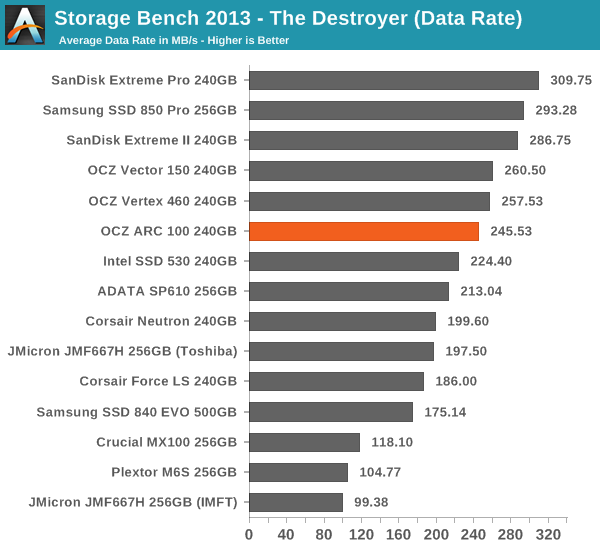OCZ ARC 100 (240GB) SSD Review
by Kristian Vättö on August 26, 2014 7:00 AM ESTAnandTech Storage Bench 2013
Our Storage Bench 2013 focuses on worst-case multitasking and IO consistency. Similar to our earlier Storage Benches, the test is still application trace based – we record all IO requests made to a test system and play them back on the drive we are testing and run statistical analysis on the drive's responses. There are 49.8 million IO operations in total with 1583.0GB of reads and 875.6GB of writes. I'm not including the full description of the test for better readability, so make sure to read our Storage Bench 2013 introduction for the full details.
| AnandTech Storage Bench 2013 - The Destroyer | ||
| Workload | Description | Applications Used |
| Photo Sync/Editing | Import images, edit, export | Adobe Photoshop CS6, Adobe Lightroom 4, Dropbox |
| Gaming | Download/install games, play games | Steam, Deus Ex, Skyrim, Starcraft 2, BioShock Infinite |
| Virtualization | Run/manage VM, use general apps inside VM | VirtualBox |
| General Productivity | Browse the web, manage local email, copy files, encrypt/decrypt files, backup system, download content, virus/malware scan | Chrome, IE10, Outlook, Windows 8, AxCrypt, uTorrent, AdAware |
| Video Playback | Copy and watch movies | Windows 8 |
| Application Development | Compile projects, check out code, download code samples | Visual Studio 2012 |
We are reporting two primary metrics with the Destroyer: average data rate in MB/s and average service time in microseconds. The former gives you an idea of the throughput of the drive during the time that it was running the test workload. This can be a very good indication of overall performance. What average data rate doesn't do a good job of is taking into account response time of very bursty (read: high queue depth) IO. By reporting average service time we heavily weigh latency for queued IOs. You'll note that this is a metric we have been reporting in our enterprise benchmarks for a while now. With the client tests maturing, the time was right for a little convergence.

The good IO consistency translates into good performance in our 2013 Storage Bench. The ARC 100 is without a doubt the fastest value drive in the market for heavy IO workloads as the 840 EVO and MX100 do not even come close.











54 Comments
View All Comments
Anato - Thursday, August 28, 2014 - link
Those pull down menus are pain to use. Please use old buttons instead. Thanks!MHz Tweaker - Sunday, August 31, 2014 - link
Of the 12 SSD's I have purchased in the last 5 years.....qty 4 Vertex 2's
qty 1 HyperX 3K
qty 2 Vertex 4's
qty 3 Samsung EVO's
qty 2 Samsung 840 Pro's
I have had 2 failures, both OCZ drives (one Vertex 2 and one Vertex 4)
The Vertex 2 died within a few months of purchase
The Vertex 4 died in just under a year
My top choice would be Samsung then 2nd Crucial and maybe another HyperX 3K drive 3rd
danwat1234 - Wednesday, January 21, 2015 - link
In the article, I don't really see how the Arc 100 , Vector 150, Vertex 460 isn't OK for the laptop crowd. It is only taking half a watt at idle, less than a typical 5400RPM laptop drive of about 1 watt. It is unfortunate DIPM isn't supported but no big deal.In the article, doesn't the Arc 100, Vector 150 and Vertex 460 all use the same 19nm flash, but you say the Arc 100 uses slower flash? I know the controller in the Vertex460 and Arc 100 is slower than in the Vector 150 (350 vs 400MHZ or so) and I think slightly slower DRAM cache speed.
Thanks
danwat1234 - Wednesday, January 21, 2015 - link
Also how much lower is the Arc 100 120GB version in performance versus 240GB? Less die means less performance..